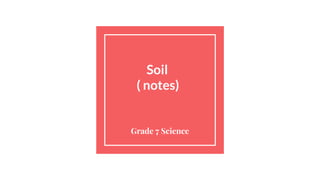
Soil ( notes)
- 1. Soil ( notes) Grade 7 Science
- 2. What is soil ? It forms the upper surface of the earth where life thrives and is the base of all agriculture. Due to the physical and chemical weathering of rocks, it comprises of minerals and gravel, microbes, insects, decaying organic matter (humus), nutrients, water, and air.
- 3. What is a soil profile ? A soil profile is a vertical cross-section of the soil, made of layers running parallel to the surface. These layers are known as soil horizons. The soil is arranged in layers or horizons during its formation. These layers or horizons are known as the soil profile.
- 4. What are the horizons ? Each layer in a soil profile is defined as a horizon. 1. A- horizon or topsoil is the soft, porous layer which can absorb and hold more water. 2. B-horizon or middle layer is the more compact and harder layer. 3. C-horizon is the third layer made up of small rocks. 4. Bedrock is the fourth and hardest layer.
- 5. Horizons O (humus or organic): Mostly organic matter such as decomposing leaves. The O horizon is thin in some soils, thick in others, and not present at all in others. A (topsoil): Mostly minerals from parent material with organic matter incorporated. A good material for plants and other organisms to live. B (subsoil): Rich in minerals that leached (moved down) from the A or E horizons and accumulated here. C (parent material): The deposit at Earth’s surface from which the soil developed. R (bedrock): A mass of rock such as granite, basalt, quartzite, limestone or sandstone that forms the parent material for some soils – if the bedrock is close enough to the surface to weather. This is not soil and is located under the C horizon.
- 6. What is weathering ? Weathering is the breaking down or dissolving of rocks and minerals on Earths surface. Water, ice, acids, salt ,plants, animals, and changes in temperature are all agents of weathering.
- 7. Define Humus ? Humus is the organic component present in the soil formed by the decomposition of plant materials by microorganisms present in the soil. Humus is the rotting dead matter in the soil.
- 8. What are the types of soil ? Sandy : The soil is classified on the basis of the proportion of particles of various sizes. Sand tends to have large particles and the particles are solid and have no pockets where water and nutrients can hold to it. Because of this, water and nutrients tend to run out, and because sandy soil lacks both water and nutrients, many plants have a difficult time surviving in this kind of soil Clayey : The clayey soil consists of a larger proportion of finer particles. Clay soils contain more than 30 percent fine clay particles. Clays swell and shrink as they wet and dry, effectively cultivating themselves. Loamy: When the proportion of larger and finer particles are equal, then that type of soil is called as loamy soil. ● Loamy soil is a mixture of silt, clay and sand which is the best topsoil for growing plants.
- 9. What is percolation ? Percolation is the process of filtering liquid while passing through a filter. Rainfall seeps underground through percolation, where water travels downwards through the tiny spaces between rocks and soil particles. The water eventually saturates the underlying rock much like water fills the tiny holes of a sponge. This helps to replenish aquifers under the ground.
- 10. Percolation rate formula Percolation rate (mL/ min) = amount of water (mL)/percolation time (min).
- 11. To percolate 200 ml of water , the time taken is 20 minutes. Calculate the percolation rate? Solution Amount of water = 200 mL Time taken for percolation = 20 minutes
- 12. What is percolation rate ? ● Percolation rate of soil is used to determine the absorption rate of the soil. ● The rate of percolation is the ratio of the amount of water in millimetres to the percolation time in minutes.
- 13. Formation of soil Soil is formed when the weathering of rocks takes place, and they break down into tiny pieces that form the soil. The various methods by which soil is formed include mechanical weathering, chemical weathering and biological weathering.This implies that it is a mixture of rocks which are broken into smaller particles and the dead and decayed organic matter along with the little microbes.Soil is an important element essential for the survival of living organisms ● The fertile soil helps in the growth and development of the plants. ● It supports many life forms including bacteria, fungi, algae, etc. ● The organic matter present in the soil increases the fertility of the soil, which is responsible for the growth of the plants.
- 14. Identify the type of soil Hint : particles of differ in various sizes . Sandy soil , clayey soil ,loamy soil Choose the following
- 15. Summary U have leant about soil .
- 16. Test your self 1. What is subsoil ? 2 . what layer is know as parent rock? 3. To percolate 400 ml of water , the time taken is 40 minutes. Calculate the percolation rate? 4 . what is soil ? 5 .define percolation
- 17. The End
